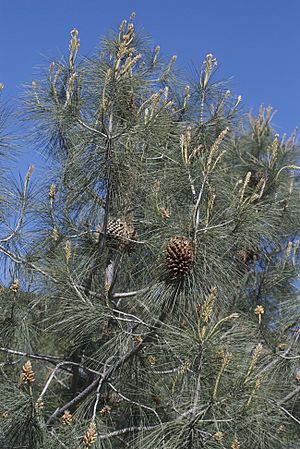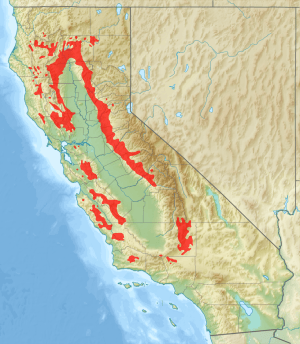Pinus sabiniana facts for kids
Quick facts for kids Pinus sabiniana |
|
|---|---|
 |
|
| Conservation status | |
| Scientific classification | |
| Genus: |
Pinus
|
| Species: |
sabiniana
|
The Pinus sabiniana, also known as the foothill pine or gray pine, is a special type of pine tree. It grows only in California, United States. You might also hear it called "digger pine," but some people prefer not to use that name.
Contents
What is the Foothill Pine Like?
This pine tree usually grows to be about 36 to 45 feet (11 to 14 meters) tall. Some can even reach 105 feet (32 meters)! Its needles are a unique pale gray-green color. They hang down and are grouped in bundles of three. These needles can be quite long, about 8 to 12 inches (20 to 30 centimeters).
The cones of the foothill pine are big and heavy. They are usually 5 to 14 inches (12 to 35 centimeters) long and almost as wide. When they are fresh, these cones can weigh from 0.7 to 1.5 pounds (0.3 to 0.7 kilograms). Sometimes they weigh over 2 pounds (1 kilogram)! The smaller male cones grow on the lower branches of the tree.
Where Does the Foothill Pine Grow?
You can find Pinus sabiniana from sea level up to about 4,000 feet (1,200 meters) high. It is very common in the northern and inner parts of California. It grows all over the Sierra Nevada and California Coast Ranges foothills. These foothills surround California's big central valleys. You can also find it in the Transverse Ranges, Peninsular Ranges, and even in "sky islands" in the Mojave desert. These "sky islands" are like tall, isolated mountains in the desert.
This tree is very good at living through long, hot, dry summers. It can grow in places with very different amounts of rain. Some areas get only 10 inches (250 mm) of rain a year, while others get up to 70 inches (1,780 mm)! It likes rocky, well-drained soil. But it can also grow in tough soils like serpentine soil or heavy clay. It often grows near oak trees. When you see "Oak/Foothill Pine vegetation," it means you are in a special habitat type in California. Here, the pine trees form a thin upper layer above the oak trees.
How is the Foothill Pine Used?
The needles of the Pinus sabiniana are the only food source for the caterpillars of a certain moth called Chionodes sabinianus.
Long ago, some Native Americans in California used the sweet pine nuts from this tree as a very important food source. They also ate the roots of the tree. It is thought that their use of the nuts helped spread the trees to where they grow today.
Why is it Called the Foothill Pine?
The name "digger pine" was supposedly used because Paiute people would dig around the base of the tree to find its seeds. However, it is more likely that the term "Digger Indians" was first used to describe the people themselves in the 1800s. Even though "digger pine" was a common name for a long time, many people now avoid it. They feel the word "digger" was used in a way that was not respectful.
The scientific name for the tree, sabiniana, honors Joseph Sabine. He was a secretary for a gardening society in London.
Images for kids




